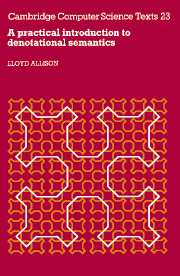Book contents
8 - Data structures and data types
Published online by Cambridge University Press: 05 June 2012
Summary
There is great variety amongst programming languages in the area of data structures and type checking. It is only possible to deal with some of the more straightforward issues in this chapter.
Some languages, such as BCPL [52], are typeless, or have only one type. All BCPL variables have the type ‘word’. This enables BCPL to rival assembly code in application while being much more readable and concise. There are dangers, however; the compiler cannot detect type errors because there are none.
Languages that do provide types are characterized by the kind of data structures, the time at which types are checked and how much the programmer can define. Simple types, such as integer, stand for basic domains like Int. Structured types – arrays and records – stand for derived domains. There are hard problems, however, in deciding what a programmer-defined type, particularly one defined by possibly recursive equations, stands for – see recent conference proceedings [1, 2, 31]. This is obviously connected with recursive domains (§4.3).
APL [27] is a dynamically typed language. Each constant has a particular type – integer, character or vector or array of one of these. The value currently assigned to a variable therefore has some type, but both the value and the type may change as the program runs. Each APL operator is only applicable to certain types, so it is possible to add 1 to an integer or to a vector of integers but not to a character.
- Type
- Chapter
- Information
- A Practical Introduction to Denotational Semantics , pp. 94 - 101Publisher: Cambridge University PressPrint publication year: 1987



